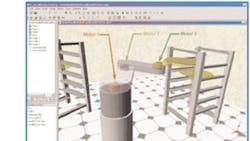Get virtual
Designing a motion system is an iterative process that approaches an optimum solution. Perfection is the goal, but, given time and cost constraints, almost any system that works may be considered a success. The degree of success is largely a reflection of the design process itself. In general, designers produce the best solutions when they can make interdisciplinary trade-offs late into the development cycle.
That said, the most powerful design optimization technology available to motion system engineers today is virtual prototyping. Here, computer models play the role of physical prototypes, giving engineers information that would otherwise require a conventional “build-it-and-break-it” approach. The flexibility inherent in software makes revisions relatively easy at any point in the design.
Designing the virtual way is a multi-step process that harnesses the power of several software applications. The steps include “building” the virtual system using CAD software, “moving” it with a motion simulator, “controlling” it with a control system design package, “breaking” it using structural analysis software, and “showing” it via visualization tools. The iterative nature of the process demands the free and continuous flow of information between the various applications.
Chip designers were perhaps the first to reap the benefits of virtual prototyping. Using computer models instead of breadboards, meters, and wires, IC engineers have revolutionized the world. Now, history is set to repeat itself in the realm of electromechanical motion systems.
What makes virtual motion-system prototyping a reality is a combination of computer and software technology. CAD systems now interact seamlessly with FEA software, motion simulators, and control development packages. And, because today’s computers are fast and inexpensive, almost any designer can afford to do virtual prototyping on his or her desktop.
Exactly what a designer does with the tools depends on the goal. Virtual testing can be as simple as visualizing the motion of a device, or as complex as predicting the operating conditions that lead to part failure in a simulated system.
A good example of how virtual prototyping can benefit electromechanical design is the case of an engineer trying to optimize a system by reducing the mass of its components. It is well known that the less mass in a system, the lower the power requirements and the more responsive the control. It is also well known that removing volume or using lighter materials has structural implications. What virtual prototyping does is allow the designer to more quickly explore trade-offs and what-if scenarios; in this case, to see precisely how structural integrity is affected.
With virtuality at their fingertips, tomorrow’s motion system designers will be able to more intelligently size motors, select materials, and optimize parts based on strength and weight. They’ll also be able to track causeand- effect relationships. Virtual prototyping can reveal, for example, when a component is stressed beyond its material limits because of something in the control algorithm. Not only that, it can help determine the optimum resolution from a system perspective. In a matter of minutes, the engineer can know, for example, if smoothing one of the corners on the velocity profile of a particular axis is going to do the trick, or if a surface treatment on one of the mechanical components is required.
